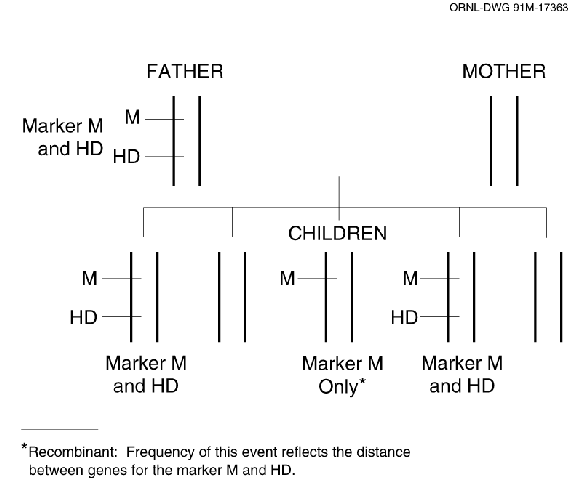


In the diagram, the vertical lines represent chromosome 4 pairs for the mother, father and children. Two of the traits that the father contains can be detected in any child who inherits them- the DNA sequence that c an be used as a marker (M) and the gene for Huntington's Disease (HD). Only child number 3 only received trait M on chromosome number 4 which indicates that during the production of sperm cells the father's genetic material recombined. The distance between two DNA sequences on a genetic map are helped to be determined from the frequency of this event.
The function of the genetic linkage map is to show, along the chromosomes, the relative locations of DNA markers. Markers can be both DNA segments that have no genes but whose traits can be followed or markers can be the genes themselves.
Alternate forms of the markers must exist (that is, they must be polymorphic) among individual people so that in family studies they are easily recognizable and detectable. Polymorphisms can occur on a DNA strand approximately every 300 to 500 bp.
Genes that determine eye color, blood type and disease susceptibility are caused due to variations within exon sequences. The variations that occur within the introns do not usually affect an organisms' appearance or function (or they affect the appearance very little), yet they are detectable at the DNA level and can be used as markers. Examples of these markers include RFLP's and tanden sequences.
The frequency of how two markers are inherited together are observed to create the human genetic linkage map.
Two markers located closely together on the same chromosome often pass together from parent to child. Meiotic recombination can result in the separation of two markers originally on the same chromosome.
As the distance between the two markers lessen, the more tightly linked they become and it is less likely that they will be separated. Thus an estimate of the distance between two markers is drawn from the recombination frequency.
The current average resolution is about 10Mb.
There are many benefits to using the genetic linkage map. For example:
| Inherited disease can be located on the map and | |
| The exact chromosomal location of several important disease genes such as Huntington's, cystic fibrosis, sickle cell disease and mytonic dystrophy have been located. |

This is a picture of the diseases that have been found on specific chromosomes in the body. Diseases are currently still being found on the chromosomes and this is one of the benefits to the human genome project.
If you click on the picture, you will be linked to a fellow students website on Huntington Disease.
cM (centimorgans) is the unit used to measure distances between markers on the genetic map. If 2 markers are separated 1% of the time they are considered to be 1_cM apart. NOTE: 1_cM roughly equals 1 000 000bp.